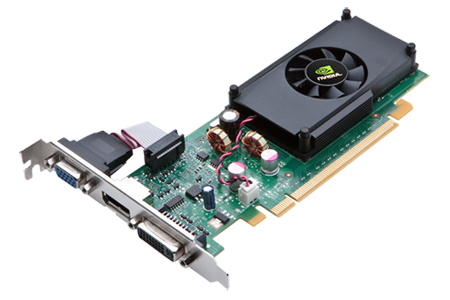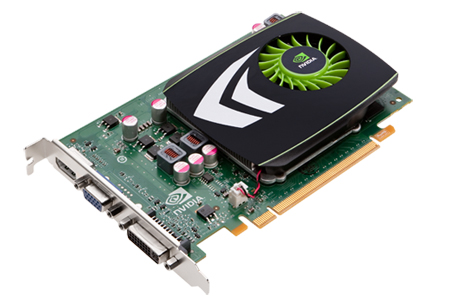NVIDIA's first 40nm desktop GPUs
Before we get to benchmarks, let's take a look at what NVIDIA's first 40nm desktop GPUs actually are, and where they fit in.
Following the introduction of the underwhelming GeForce GTS 250 back in March 2009 - which, remember, was little more than a rebranded GeForce 9800 GTX+ - one might suppose that the GeForce 210 and GeForce GT 220, too, are the result of NVIDIA's now-infamous rebranding exercise.
Fortunately those premonitions can be cast aside, because what we're looking at here are two new cards. Built on TSMC's 40nm fabrication process, these low-end solutions aim to put NVIDIA's GT200 architecture within reach of the mainstream consumer.
What's interesting is that although the retail products have been available for just a matter of weeks, NVIDIA has actually been shipping 40nm parts for months. Back in June, the company's first-ever 40nm GPUs arrived in mobile form - where efficiency and battery life are paramount.
A month later, the GeForce 210 and GeForce GT 220 - the very cards we're looking at today - arrived as desktop derivatives of the 200M-series mobile parts and were made available exclusively to OEMs. We'd assume it to be a case of limited stock, and NVIDIA wanting to make cards available to the likes of Dell and HP, whose systems are likely to take advantage of low-end add-in cards.
Going full circle, those 40nm desktop parts are now available at retail. Here's what they bring to the table.
GeForce 210

NVIDIA's entry-level card, the GeForce 210, makes use of a low-profile design and features a GPU clocked at 589MHz, 16 stream processors clocked at 1,402MHz and 512MB of DDR2 memory clocked at 1,000MHz and connecting via a 64-bit interface.
The specification is actually weaker than a GeForce 9400 GT.
GeForce GT 220

The quicker GeForce GT 220, meanwhile, features a GPU clocked at 625MHz, 48 stream processors running at 1,360MHz and a whole gigabyte of DDR3 memory operating at an effective 1,580MHz via a 128-bit interface.
Where do they fit in?
What we're looking at is GT200 architecture drastically trimmed down to slot directly into the low-end space. NVIDIA directly compares its new additions to GeForce 9-series cards dating back to Q3 2008: the GeForce 9400 GT and GeForce 9500 GT.
Comparing specifications, it's clear to see that the GeForce 210 and GeForce GT 220 are logical replacements for ageing 9-series parts.
| Graphics card | GeForce GTS 250 | GeForce GT 220 | GeForce 9500 GT | GeForce 210 | GeForce 9400 GT |
|---|---|---|---|---|---|
| GPU clock | 738MHz | 625MHz | 550MHz | 589MHz | 550MHz |
| Shader clock | 1,836MHz | 1,360MHz | 1,400MHz | 1,402MHz | 1,350MHz |
| Memory clock | 2,200MHz | 1,580MHz | 1,600MHz | 1,000MHz | 800MHz |
| Memory interface | 256-bit | 128-bit | 128-bit | 64-bit | 128-bit |
| Memory size | 512MB / 1,024MB, GDDR3 | 1,024MB, GDDR3 | 256MB / 512MB, DDR2 | 512MB, DDR2 | 256MB / 512MB, DDR2 |
| Manufacturing process | 55nm | 40nm | 55nm | 40nm | 55nm |
| DirectX / Shader Model | DX10, 4.0 | DX10.1, 4.1 | DX10, 4.0 | DX10.1, 4.1 | DX10, 4.0 |
| Stream processors | 128 | 48 | 32 | 16 | 16 |
| ROPs | 16 | 8 | 8 | 4 | 8 |
| Price (approximate) | £80 | £45 | £40 | £35 | £35 |
But are the cards necessary? And forgive us for even suggesting such a thing, but with specifications so closely matched, why not just rebrand the GeForce 9400 GT and GeForce 9500 GT as GeForce 200-series products?
There are reasons - and good ones, too. For NVIDIA, good yields should result in more GPUs being produced from a single die - making it cheaper to manufacture the 40nm parts and increase profit margins. That's the theory. Pragmatically, yields on TSMC's 40nm process are below 50 per cent right now.
For the consumer, the 40nm GPUs should run cooler and require less power. And, although they're essentially trimmed-down versions of the GT200 architecture, both cards introduce new features - including full support for Direct X 10.1 and Shader Model 4.1, finally matching what's been available from AMD's low-end parts for some time.
In addition to DirectX 10.1, NVIDIA has also thrown in a couple of features that may appeal to the home theatre PC crowd. The GeForce 210 and GeForce GT 220 are NVIDIA's first desktop parts to feature fourth-generation PureVideo HD - providing users with the added ability to offload DivX/XviD decoding, in addition to a number of previously-supported formats. On the audio front, a new on-board controller facilitates 7.1 digital surround sound via HDMI.
Last but not least, present on the older cards, for those buying into the whole GPGPU argument, the GeForce 210 and GeForce GT 220 offer full support for CUDA acceleration.









